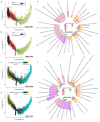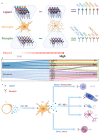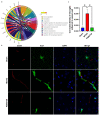Integrative Analysis of Single-Cell and Bulk Sequencing Data Depicting the Expression and Function of P2ry12 in Microglia Post Ischemia-Reperfusion Injury
- PMID: 37047745
- PMCID: PMC10095011
- DOI: 10.3390/ijms24076772
Integrative Analysis of Single-Cell and Bulk Sequencing Data Depicting the Expression and Function of P2ry12 in Microglia Post Ischemia-Reperfusion Injury
Abstract
P2ry12 is a microglial marker gene. Recently, increasing evidence has demonstrated that its expression levels can vary in response to different CNS disorders and can affect microglial functions, such as polarization, plasticity, and migration. However, the expression and function of P2ry12 in microglia during ischemia-reperfusion injury (IRI) remain unclear. Here, we developed a computational method to obtain microglia-specific P2ry12 genes (MSPGs) using sequencing data associated with IRI. We evaluated the change in comprehensive expression levels of MSPGs during IRI and compared it to the expression of P2ry12 to determine similarity. Subsequently, the MSPGs were used to explore the P2ry12 functions in microglia through bioinformatics. Moreover, several animal experiments were also conducted to confirm the reliability of the results. The expression of P2ry12 was observed to decrease gradually within 24 h post injury. In response, microglia with reduced P2ry12 expression showed an increase in the expression of one receptor-encoding gene (Flt1) and three ligand-encoding genes (Nampt, Igf1, and Cxcl2). Furthermore, double-labeling immunofluorescence staining revealed that inhibition of P2ry12 blocked microglial migration towards vessels during IRI. Overall, we employ a combined computational and experimental approach to successfully explore P2ry12 expression and function in microglia during IRI.
Keywords: P2ry12; bioinformatics; ischemia–reperfusion injury; microglia.
Conflict of interest statement
The authors declare no conflict of interest.
Figures






Similar articles
-
Ischemia/Reperfusion Induces Interferon-Stimulated Gene Expression in Microglia.J Neurosci. 2017 Aug 23;37(34):8292-8308. doi: 10.1523/JNEUROSCI.0725-17.2017. Epub 2017 Jul 26. J Neurosci. 2017. PMID: 28747383 Free PMC article.
-
Interference with long noncoding RNA SNHG3 alleviates cerebral ischemia-reperfusion injury by inhibiting microglial activation.J Leukoc Biol. 2022 Apr;111(4):759-769. doi: 10.1002/JLB.1A0421-190R. Epub 2021 Aug 19. J Leukoc Biol. 2022. PMID: 34411323
-
Expression site of P2RY12 in residential microglial cells in astrocytomas correlates with M1 and M2 marker expression and tumor grade.Acta Neuropathol Commun. 2017 Jan 10;5(1):4. doi: 10.1186/s40478-016-0405-5. Acta Neuropathol Commun. 2017. PMID: 28073370 Free PMC article.
-
Microglia and Neuroinflammation: What Place for P2RY12?Int J Mol Sci. 2021 Feb 6;22(4):1636. doi: 10.3390/ijms22041636. Int J Mol Sci. 2021. PMID: 33561958 Free PMC article. Review.
-
Role of microglia under cardiac and cerebral ischemia/reperfusion (I/R) injury.Metab Brain Dis. 2018 Aug;33(4):1019-1030. doi: 10.1007/s11011-018-0232-4. Epub 2018 Apr 14. Metab Brain Dis. 2018. PMID: 29656335 Review.
References
MeSH terms
Grants and funding
LinkOut - more resources
Full Text Sources
Miscellaneous

